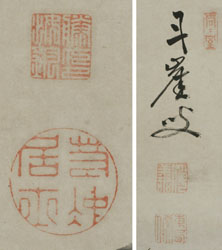Independent
BridgeSigned: Tangai shûdai
Seals: Tô Jokin in, Jakuchû Koji and Jôzen, Tôsai Nanbokujin, Nyonyodô (tp)
Technique: sumi on paper 110 x 29,4
Date: c. 1762
Mounting: ochre raw silk and light green silk 190 x 39,4
Condition: very good
The calligraphy reads: 驢馬在何処、趙州東壁東
Where are the donkeys? They are on the east side of the east wall of Zhaozhou.
This is a saying related to the to the Chinese Zen priest Zhaozhou (778-897). When a monk asked Zhaozhou: “What is the stone bridge?” he answered: “That’s the place where donkeys and horses reach to the other bank”. At the question “Where are the donkeys and the horses?” his answer was: “Right now they are east of the monastery on the bridge.” (The bridge still exists and is known to be the oldest in the world). The idea here is that all living creatures have a Buddha nature and that all are able to reach to other bank, which means, come to enlightenment. Obviously the bridge has to be regarded as Zen in this case. (HK)
Itô Jakuchû was a painter known for his individual style: versatile and experimental. Unlike the two other great individualists, Soga Shôhaku (1730-81) and Nagasawa Rosetsu (1754-99) Jakuchû was the quiet type. He was sober, restrained and devoted to Zen Buddhism. Jakuchû was the eldest son of a wholesale greengrocer at the Nishiki market in the center of Kyoto. In 1739, after his father’s death, he became proprietor. In 1755, at the age of forty, he turned the business over to a younger brother to devote himself to the arts. It seemed that at a young age he studied painting with the Kanô style artist Ôoka Shumboku (1680-1863). In his thirties Jakuchû built a studio along the Kamo River where he became involved in the cultural climate of Kyoto. He became friends with the Rinzai Zen monk Daiten Kenjô (1719-1801). Through this lifelong friendship Jakuchû became attracted to the Ôbaku sect. In this way he probably met with Musen Jôzen, who in the early 1760s added a number of san, inscriptions, to paintings that Jakuchû produced.
Reference:
Shizuoka 2010
Kyoto 2000
Hickman, Money L 1989
Satô, Nihon no Bijutsu # 256
Roberts p. 59
Rosenfield b 2
Musen Jôzen was the 18th generation head abbot of the Jikishi-an in Kyoto.
Reference:
Moog p. 318
Price: ON REQUEST

